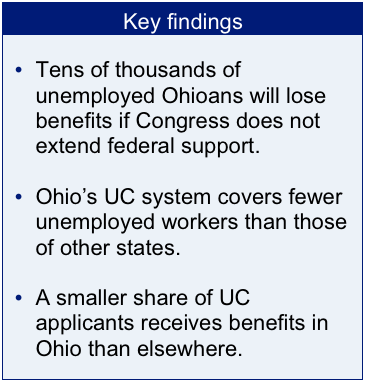
Unemployment Compensation in Ohio
November 07, 2012
Unemployment Compensation in Ohio
November 07, 2012
Download reportPress releaseIf Congress does not act by December 29, federal benefits will be cut off that have for four years sustained aid to jobless workers in Ohio and across the nation.
Already weak coverage is threatened
 Less than a quarter of Ohio’s unemployed workers are receiving state unemployment compensation benefits. For the last four years, workers in Ohio and across the country have been able to receive federally paid benefits, bolstering the share of jobless workers here who receive benefits to 39 percent in the second quarter of 2012. However, if Congress does not act by Dec. 29, such benefits will be cut off. The number of unemployed in Ohio who receive UC will drop drastically, leaving families and communities without the economic support that such benefits provide.
Less than a quarter of Ohio’s unemployed workers are receiving state unemployment compensation benefits. For the last four years, workers in Ohio and across the country have been able to receive federally paid benefits, bolstering the share of jobless workers here who receive benefits to 39 percent in the second quarter of 2012. However, if Congress does not act by Dec. 29, such benefits will be cut off. The number of unemployed in Ohio who receive UC will drop drastically, leaving families and communities without the economic support that such benefits provide.
For years, relatively fewer unemployed Ohioans have qualified for unemployment compensation than their counterparts in other states. Ohio’s tough earnings standard and disqualification of jobless workers who would be eligible for benefits elsewhere contribute to this dismal record. For instance, most states allow part-time workers who lose their jobs to seek similar part-time work and qualify for benefits, assuming they have earned enough and meet the other criteria. Ohio does not. Ohio’s current requirement that workers average at least $222 a week for at least 20 weeks over a year’s time is among the most stringent in the country.[1] For instance, it disqualifies those earning this year’s minimum wage of $7.70 an hour and working 28 hours a week. A retail employee who has worked for years at such a job would be left without benefits if she or he was laid off.
The share of Ohio unemployed receiving regular state benefits rose during the last recession, as it typically has in the past, but has again receded sharply. The share of Ohioans receiving state benefits recently – 22 percent – was the lowest of almost any time in more than 25 years (it dipped in the third quarter of last year to just 19 percent). Figure 1 shows the share of unemployed who have qualified for state benefits in Ohio compared to the United States since 1983. These percentages do not include jobless workers receiving extended benefits paid for by the federal government (see below). However, the share of Ohio’s unemployed receiving UC benefits of any kind also has remained below that in other states.[2]
Since 2008, the unemployed in Ohio as elsewhere across the country have been able to receive additional benefits after the end of their state UC benefits, which last up to 26 weeks in Ohio and most states. The Ohio Department of Job & Family Services estimated in September that if all of the claimants receiving benefits were to keep getting them for the maximum allowable period, more than 98,000 Ohioans would exhaust their benefits in December, when federally paid benefits are now due to end.[3] However, as the agency noted, this is a “worst case” analysis. It overstates the number, since many of course will find jobs or stop looking for work, whether it’s because they go back to school, take on family responsibilities or for other reasons. Nearly 50,000 Ohioans have been claiming federally supported benefits each week, the bulk of whom will have their benefits cut off if the program is not continued after Dec. 29.[4]
Figure 2 shows the share of the Ohio unemployed receiving benefits under all UC programs, state and federal, compared with those receiving state benefits. Federal benefits were extended through Dec. 29 but cut back earlier this year so that claimants cannot receive benefits for as many weeks (Currently, qualified Ohioans may receive up to an additional 37 weeks of federally paid benefits). In April, for instance, more than 30,000 Ohioans exhausted their benefits, mostly because of a reduction in one of the federally-supported UC programs.[5] Altogether, according to the ODJFS, 197,279 Ohioans exhausted all of their unemployment compensation benefits between July 2009 and July 2012.[6]
Congress and then President George W. Bush approved extended benefits starting in mid-2008, just as in seven previous recessions. This is because high unemployment makes it hard to find a job, so families and communities need an additional backstop. In the year ended in September, the average Ohioan without a job was unemployed for 33.5 weeks, according to data from the U.S. Bureau of Labor Statistics.[7] Indeed, during the recent recession and the ensuing period of a weak economy, the nation has seen the highest levels of long-term unemployment recorded since such records started being kept in the 1940s. According to a U.S. Department of Labor survey, there were 3.5 unemployed workers for every job opening as of August.[8] Congress has never ended this extra aid when U.S. unemployment was this high.[9] While the Ohio unemployment rate has fallen substantially from its peak, the state is still 243,000 jobs short of replacing those it has lost since the recession officially started in December 2007 – and that doesn’t take into account population growth since then.[10]
According to the U.S. Census Bureau, unemployment compensation kept 2.3 million people from falling into poverty in 2011.[11] Unemployment benefits also provide vital support to communities, since jobless workers are likely to spend nearly all of their benefits, with consequent effects for local economies. Previous studies have shown that unemployment compensation helps stabilize the economy, creating additional demand for goods and services.[12] As a result, many economists consider unemployment compensation to be one of the best ways of shortening recessions or boosting recoveries. During the first nine months of 2012, the federal program paid more than $788 million to unemployed Ohioans.[13] The loss of these funds would negatively affect the state economy.
Ohio is not particularly generous, however, when it comes to evaluating the eligibility of claimants for UC. As Figure 3 shows, relatively fewer applicants from Ohio end up receiving UC benefits than claimants from across the country.[14] In 2011, according to data from the U.S. Department of Labor, 63 percent of Ohioans who filed initial claims for unemployment insurance benefits received first payments of those benefits. By comparison, 71 percent of claimants across the United States received their first benefits.
While the difference between the Ohio and U.S. numbers varies from year to year, the pattern has been the same for the last decade: A smaller share of Ohio applicants has received benefits. To receive benefits, Ohio claimants must have worked at least 20 weeks and earned enough, and they have to have lost their most recent job due to layoff, discharge due to no fault of their own, or quit for just cause. In addition, for each week claimed, claimants must be able, available, and actively seeking work, and they must not have refused an offer of suitable work or had other income that would disqualify them. Figure 3 indicates that Ohio’s eligibility rules and the process it uses for determining eligibility in Ohio are at least as stringent, if not more so, than those of other states across the country.
Ohio’s unemployment compensation system already covers too few of our unemployed. Congress should continue federal support for UC benefits to avoid the loss of benefits for tens of thousands of Ohioans and the negative effects that would have on their families and communities.
[1] See “Ohio Still Excludes Many from Unemployment Compensation,” Policy Matters Ohio, December 17, 2007, available at http://bit.ly/TYzSz7, and U.S. Department of Labor, Employment and Training Administration, “Comparison of State Employment Laws,” pp. 3-5 to 3-7, available at http://1.usa.gov/Rws76A.
[2] See U.S. Dept. of Labor, Employment and Training Administration, UI Data Summary, 2nd Quarter 2012, available at http://1.usa.gov/PrU3ZI. In the 12 months ended in June, 44 percent of Ohio’s unemployed received UC benefits, compared with 49 percent for the country as a whole. Ohio ranked 40th in this measure, known as the “recipiency rate.”
[3] Ohio Department of Job & Family Services, Office of Unemployment Compensation, “Estimated Unemployment Exhaustion Data: Ohio,” Estimated Number of Exhaustions by Month of Exhaustion, p. 1
[4] According to ODJFS, 49,698 Ohioans filed continued claims for the week ended Oct. 27 under the federal Emergency Unemployment Compensation (EUC) program (see Claim Trends, available at http://bit.ly/VIhufb).
[5] Ohio Department of Job & Family Services, Office of Unemployment Compensation, “Estimated Unemployment Exhaustion Data: Ohio,” Estimated Number of Exhaustions by Month of Exhaustion, p. 1. The Extended Benefits program, a state-federal program that provides up to 20 weeks of benefits and had been paid for by the United States, ended for nearly all Ohioans in April.
[6] Ohio Department of Job & Family Services, Office of Unemployment Compensation, “Estimated Unemployment Exhaustion Data: Ohio,” Sept. 6, 2012, p. 3. July 2009 is when the first unemployed began running out even of the additional benefits extended by the federal government a year earlier.
[7]Calculation by Mike Evangelist of the National Employment Law Project from data from U.S. Bureau of Labor Statistics
[8] Shierholz, Heidi, Economic Policy Institute, “Job-Seekers ratio down slightly in August, and likely dropped further in September,” Oct. 10, 2012, available at http://www.epi.org/publication/job-seekers-ratio-october-2012/
[9] On average, the national unemployment rate was 6 percent when Congress ended federal support for extra benefits after previous recessions. In one case, in 1985, Congress ended the program when the U.S. unemployment rate was 7.2 percent. The current EUC program is tiered, so that states that experience drops in unemployment see a reduction in benefits available. For instance, if the existing EUC program is extended and Ohio’s three-month average unemployment rate drops below 7.0 percent, the federal program would only pay for 28 weeks of extra benefits instead of the current 37. See National Employment Law Project, Phase Out of Federal Unemployment Insurance Benefits, Fact Sheet, September 2012, available at http://www.nelp.org/page/-/UI/2012/EUC_fact_sheet.pdf?nocdn=1
[10] Policy Matters Ohio, “Ohio Jobs Data Send a Mixed Message,” Oct. 19, 2012, available at http://bit.ly/QbFef5.
[11] Carmen DeNavas-Walt, Bernadette D. Proctor and Jessica C. Smith, U.S. Census Bureau, “Income, Poverty and Health Insurance Coverage: 2011,” Issued September 2012, p. 20, http://1.usa.gov/QZKsHO.
[12] A number of these studies are cited in “Courting Crisis: Ohio Policy Has Undermined Unemployment Compensation Fund,” Zach Schiller, Policy Matters Ohio, October 2011, pp. 12-13, available at http://bit.ly/QZKEGW.
[13] Policy Matters Ohio analysis of data available from the U.S. Department of Labor at http://1.usa.gov/X6GT7s.
[14] Data for this chart were provided at Policy Matters Ohio’s request by the U.S. Department of Labor. It compares the number of new, intrastate claims, including the regular state program and programs covering federal employees and ex-service members, with the number of first payments made to claimants under those programs. This is covered in the ETA 5159 report for claims and payment activities. It excludes transitional claims, which involve workers who have reached the end of a benefit year and must file new state claims to continue receiving federally paid benefits.
Tags
2012Unemployment CompensationZach SchillerPhoto Gallery
1 of 22


